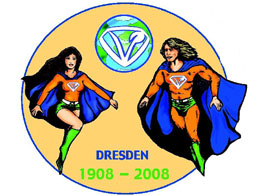
38th IVU World Vegetarian Congress - 100 Years of Food Revolution
A joint event of the International Vegetarian Union (IVU), and the Vegetarier-Bund Deutschlands

Topics to be discussed
Specific topics:
- Milk: cure or cause of osteoporosis?
- Protein: never a problem on an animal-free diet or requires careful food combining?
- The "blood group diet"
- Soya: poison or panacea?
- Vitamin B12: where can we really get it and why?
- "Vegan diets are healthiest" versus "animal products are essential".
Underlying topic:
- How to judge health claims
Milk: cure or cause of osteoporosis
Milk | 1 time per week or less | 1-6 times per week | 1 time per day | 2 or more times a day |
Risk of hip fracture | 1.00 | 1.36 | 1.23 | 1.45 |
Relative risk of hip fracture in postmenopausal women versus frequency of milk consumption USA Nurses' Health study (1997)
So how have these results have been used?
Most vegan/animal rights activists know about this 1997 study. Viva, PETA, PCRM etc highlight these prominently in their current literature and websites.
http://www.milksucks.com/osteo.asp:
But Don't Take Our Word for It - Examine the Science for Yourself....
Harvard University's landmark Nurses Health Study, which followed 78,000 women over a 12-year period, found that the women who consumed the most calcium from dairy foods broke more bones than those who rarely drank milk.
http://www.pcrm.org/health/prevmed/strong_bones.html:
Calcium and Strong Bones
In fact, in a 12-year Harvard study of 78,000 women, those who drank milk three times a day actually broke more bones than women who rarely drank milk.
http://www.viva.org.uk/guides/motherandbaby.htm:
The Harvard Nurses' Health Study, took 77,761 women, aged 34 to 59 and followed them for 12 years. The research found that those who got more calcium from milk actually had slightly, but significantly, more fractures, than those who drank little or no milk
The message is that milk causes osteoporosis
Why is this use of the 1997 study results an example of myth making?
Milk | 1 time per week or less | 1-6 times per week | 1 time per day | 2 or more times a day |
Risk of hip fracture | 1.00 | 1.36 | 1.23 | 1.45 |
1997 results (as shown previously)
Milk | Less than 1 time per week | 1-3.9 | 4-6.9 times per week | 1-1.4 times per day | 1.5 times per day or more |
Risk of hip fracture | 1.00 | 1.13 | 0.85 | 1.02 | 0.83 |
2003 results from same study with six years additional monitoring and five times as many fractures
The perils of selective citation
The 2003 results override the earlier 1997 results and indicate that milk consumption in the USA is more likely to be slightly beneficial than harmful.
Few vegan activists have heard about the updated 2003 results (based on over five times as many cases as in 1997) or about other studies that contradict the idea that "Milk causes osteoporosis".
This leads to confident but ill-founded claims about scientific evidence on milk and is a good illustration of the problem of selective citation. PETA, Viva and PCRM all make extensive use of selective citation.
Selective citation convinces the converted but provokes distrust and even ridicule in the unconverted.
Looking at real-life vegans
The UK EPIC-Oxford study found that vegans had a 30% higher risk of fracture than other vegetarians, fish-eaters and meat-eaters. This difference disappeared when the comparison was limited to people eating more than 525 mg per day of calcium.
Looking at all diet groups combined, the relative risks in women for different calcium intakes (in mg per day) were:
<525 | 525-699 | 700-899 | 900-1199 | >1200 |
1.75 | 1.34 | 1.15 | 1.05 | 1.00 |
Getting adequate calcium, from milk or otherwise, is an important part of protecting against osteoporosis.
Protein: never a problem or requires careful food combining?
A diet high in oil, sugar or fruit can easily have too little protein.
If no oils or sugars are eaten then many plant foods, including potatoes and oats, provide sufficient protein per calorie by themselves.
If a large part of the diet is low protein foods then including beans, peas or lentils is necessary to meet protein needs.
A varied diet based on other plant foods including some peas, beans or lentils will meet protein needs without any special attention.
Combining grains with beans in individual meals is not necessary, but including some peas, beans or lentils most days is a good idea as they are both rich in protein and high in the amino acid lysine which is low in many grains, nuts and seeds.
Protein and amino acids in foods per 1000 kcal
Food | Protein | Lysine | methionine + cysteine | Food | Protein | Lysine | methionine + cysteine |
Apples | 3.22 | 0.20 | 0.08 | Brown rice | 23.24 | 0.89 | 0.80 |
Apricots | 29.17 | 2.02 | 0.19 | Oats | 43.42 | 1.80 | 1.85 |
Avocados | 12.30 | 0.58 | 0.36 | Rye bread | 32.82 | 0.90 | 1.20 |
Bananas | 11.20 | 0.52 | 0.30 | Wholewheat bread | 39.43 | 1.23 | 1.50 |
Blueberries | 11.96 | 0.21 | 0.32 | Wholewheat spaghetti | 42.98 | 0.95 | 1.59 |
Dates | 7.16 | 0.22 | 0.24 | Pumpkin seeds | 41.59 | 3.11 | 1.45 |
Figs | 10.14 | 0.41 | 0.24 | Tahini | 28.57 | 0.92 | 1.52 |
Grapes | 9.30 | 0.21 | 0.46 | Almonds | 36.78 | 1.04 | 0.81 |
Orange juice | 15.56 | 0.20 | 0.18 | Brazil nuts | 21.86 | 0.82 | 2.08 |
Oranges | 20.00 | 1.00 | 0.64 | Cashews | 32.19 | 1.64 | 1.33 |
Pears | 6.61 | 0.24 | 0.15 | Hazel nuts or filberts | 23.81 | 0.67 | 0.79 |
Pineapple | 7.96 | 0.51 | 0.27 | Macadamia nuts | 11.02 | 0.03 | 0.04 |
Plantains | 10.66 | 0.49 | 0.30 | Peanuts | 40.48 | 1.45 | 1.02 |
Strawberries | 20.33 | 0.83 | 0.20 | Baked beans | 51.51 | 3.54 | 1.33 |
Tangerines | 14.32 | 0.73 | 0.45 | Blackeyed beans | 66.64 | 4.51 | 1.68 |
Cassava | 8.50 | 0.28 | 0.24 | Chick peas | 54.02 | 3.62 | 1.43 |
Potato | 26.23 | 1.64 | 0.77 | Kidney beans | 77.15 | 5.29 | 2.00 |
Sweet potato | 15.71 | 0.77 | 0.51 | Lentils | 77.76 | 5.43 | 1.68 |
Taro | 13.39 | 0.60 | 0.46 | Mung beans (sprouted) | 96.67 | 5.86 | 1.76 |
Turnips | 33.33 | 1.33 | 0.59 | Peas | 66.91 | 3.91 | 1.41 |
Yam | 12.97 | 0.50 | 0.34 | Soy milk | 83.33 | 5.42 | 2.64 |
Red peppers | 32.96 | 1.44 | 1.04 | Soybeans | 87.59 | 5.24 | 1.87 |
Tomatoes | 48.42 | 1.79 | 1.05 | Tofu | 106.32 | 7.00 | 2.83 |
Asparagus | 99.13 | 4.70 | 2.13 | Beef | 72.67 | 6.05 | 2.67 |
Broccoli | 106.43 | 5.04 | 1.93 | Cheddar cheese | 61.79 | 5.14 | 1.93 |
Cabbage | 57.60 | 2.68 | 1.04 | Chicken | 86.51 | 7.02 | 3.45 |
Carrots | 23.95 | 0.93 | 0.35 | Egg | 81.16 | 5.83 | 4.41 |
Cauliflower | 79.20 | 4.24 | 2.04 | Lamb | 63.22 | 5.58 | 2.38 |
Kale | 66.00 | 3.94 | 1.52 | Milk, full fat | 53.93 | 4.28 | 1.85 |
Spinach | 129.13 | 7.91 | 3.91 | Pork | 36.99 | 3.27 | 1.37 |
Target | 25.00 | 1.00 | 0.50 | Target | 25.00 | 1.00 | 0.50 |
The blood group diet
The blood group diet is popular with some naturopaths and argues that people with different blood groups (A/B/O) require different diets for best health.
More specifically it is claimed that blood group A appeared with the advent of agriculture about 6,000 years ago and that therefore people with blood groups O and B are ill-adapted to the grains and beans of an agricultural diet and need meat in their diet and only people with blood group A are suited to a vegetarian diet.
In reality blood group A has existed for millions of years and is found in other great apes as well as humans.
The only other evidence for the "Blood group diet" is the informal clinical observations of its practitioners. Such informal observations lie behind many contradictory health claims and are notoriously unreliable.
Soya: poison or panacea?
The highest traditional consumption of soya is in Japan which has the highest healthy life expectancy of any country. It shows none of the problems attributed to high soya intake.
Most of the arguments against soya come from animal studies (both unethical and inadequate for any recommendations for humans) or from isolated studies of people that have not been confirmed by other studies.
Isolated study results are often due to "confounding" by other related factors. For example, people eating certain foods may be poorer or local versions of a food may have exceptional contaminants (e.g. tofu may be contaminated by aluminium or formaldehyde). Isolated and unconfirmed results may also be simply due to chance.
Soya: useful but not extraordinary
For most of the claimed benefits (and harms) the evidence is weak and contradictory.
Soya protein does seem to have a modest effect in reducing cholesterol.
Overall, it seems that moderate use of soya, particularly in traditional forms (such as soya milk, tofu and tempeh) is safe and healthful and provides a useful source of protein with little saturated fat. Soya milk also provides a convenient alternative to animal milks.
Myths about Vitamin B12
"You can get B12 from...
chocolate, comfrey, unwashed vegetables, water cress, nori, spirulina, organic food, raspberries, miso, tempeh, mushrooms, hazelnuts etc etc etc"
"You can make and absorb B12 from your intestines...
... if you eat a raw food diet
... if you were brought up on vegan diet"
"The need for specially added vitamin B12 shows plant-only (vegan) diets to be unnatural"
"Apes get enough B12 from plants, so we should too."
Vitamin B12: background
True vitamin B12 activates two enzymes within the body:
one converts homocysteine to methionine and simultaneously converts folate from an inactive to an active form;
the other breaks down methylmalonic acid (MMA) produced in the digestion of fatty acids.
If there is insufficient B12, then homocysteine and MMA levels both increase.
Increased homocysteine can also be caused by other factors, so the most reliable test for true vitamin B12 is the ability to reduce MMA levels.
Vitamin B12 sources
Direct measurement of vitamin B12 is difficult as there are many similar compounds (analogues) which can be difficult to distinguish.
This has generated a whole mythology based on inaccurate reports that certain foods contain vitamin B12.
For example, some tests suggested that spirulina contained B12, but repeated trials in humans have shown that it is an inactive analogue: it does not correct clinical deficiency symptoms and it does not reduce MMA levels.
The best available chemical testing (based on chromatography) has shown that about 97% of the B12-like compounds in spirulina are analogues - explaining the lack of effect.
Sophisticated chemical testing can avoid the need for expensive human testing: anything that is mostly analogues can be rejected without further testing.
Dried nori (dulse) showed just 65% analogues and 35% true B12, but human trials showed that large amounts of nori actually increasedMMA levels - so it was worse than useless.
Of all the algae, only two have been shown to contain mostly true B12: chlorella and pleurochrysis carterae.
Neither chlorella nor pleurochrysis carterae have been subjected to an adequate human trial.
The Vegan Society carried out a small trial comparing spirulina and chlorella in twelve people with elevated MMA.
Only five people completed the full trial.
The four people on spirulina showed no benefit.
The one person on chlorella showed normal MMA levels after the trial.
This is too small a trial to prove chlorella is an adequate source of vitamin B12, but it will hopefully encourage further trials.
No claim that a food contains B12 should be accepted unless a reliable independent authority has confirmed that it provides sufficient true B12 to maintain normal MMA levels.
As so many previous claims have proved false, the burden of proof must be placed on the seller.
All sources verified as being effective use B12 that has been produced by specific bacterial fermentation reactions and then used in fortified foods or supplements.
No animal products are used in this process.
Fortified soya milk, fortified nutritional yeast and conventional supplements have been shown to be effective.
There are currently no reliable plant sources of vitamin B12 other than fortified foods and supplements.
Vitamin B12 from the intestines?
Myth (untrue):
"You can make and absorb B12 in your intestines...
... if you eat a raw food diet
... if you were brought up on vegan diet"
All studies of raw food vegans have shown poor B12 levels.
Even second generation vegans show high homocysteine levels.
B12 is made by bacteria in the lower (large) intestine but is absorbed only in the upper (small) intestine.
Some primates obtain "intestinal" B12 by eating their own faeces, but this is neither necessary nor advisable for modern humans.
Vitamin B12 and "natural" diets
Vitamin B12and “natural” diets
"The need for specially added vitamin B12 shows plant-only (vegan) diets to be unnatural"
"Apes get enough B12 from plants, so we should too."
Apes get their B12 from insect and bacterial contamination of food and, in some cases, from deliberate consumption of insects, faeces, or other animals.
Modern vegans eat hygienically prepared food and do not deliberately eat any animal substance, including insects.
Modern plant foods are unnaturally clean, and necessarily so in our overpopulated world - hence the need for a reliable source of B12 from controlled bacterial fermentation.
Animal products: essential or harmful to health
Some evidence on the health impacts of animal products comes from comparisons of thousands of individual people taking into account factors such as age, sex and smoking. Other, much less reliable, evidence comes from comparisons of a small number of countries or regions which differ from each other in many aspects of diet, lifestyle and healthcare.
Some evidence is presented as direct and easily understood mortality comparisons. Others (such as the popular but idiosyncratic interpretation of the China Study promoted by Colin Campbell) use a series of indirect arguments while not presenting straightforward mortality data for varying intakes of animal products.
Campbell's claim that comparisons of 65 rural Chinese villages show that reducing animal products to zero would reduce risk of major causes of death in developed countries does not stand up to scrutiny.
Death rates versus animal protein intake in rural China
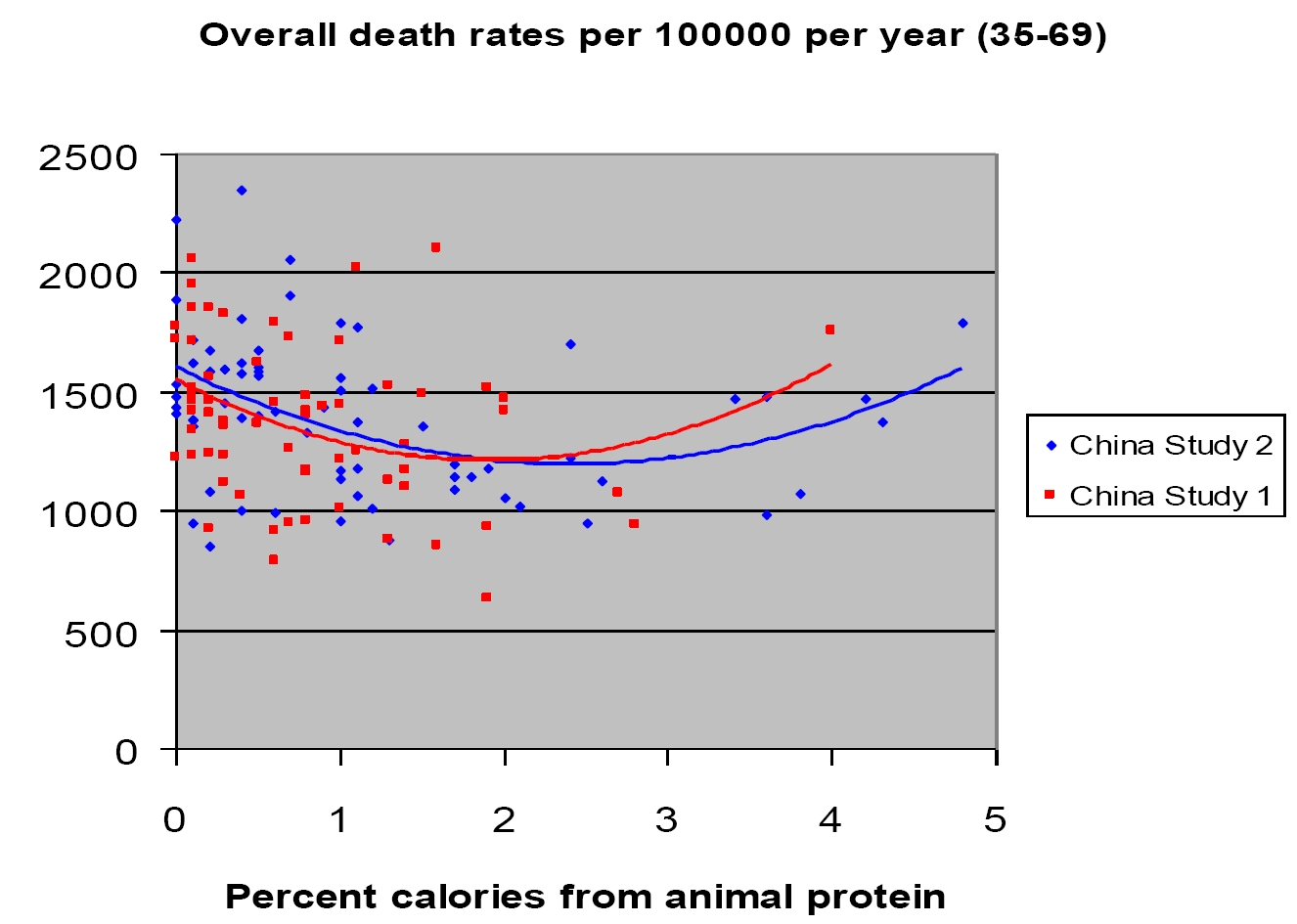 |
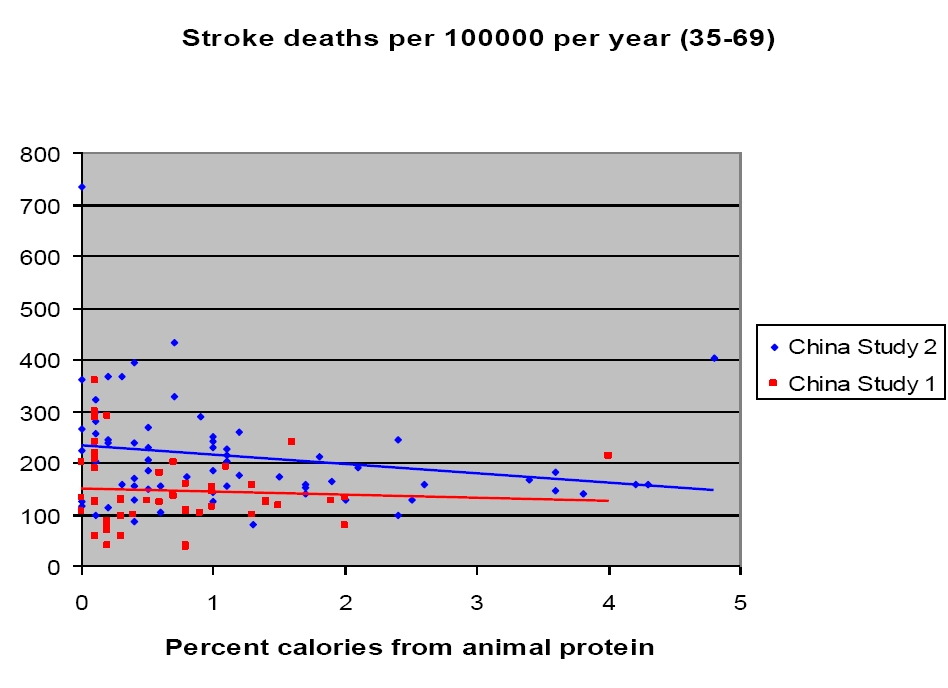 |
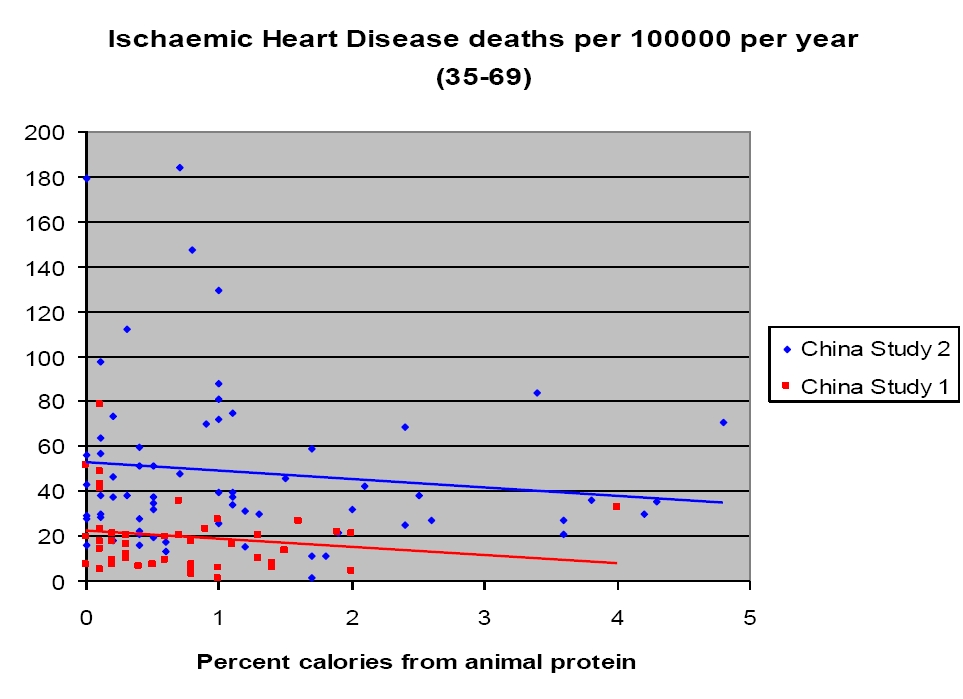 |
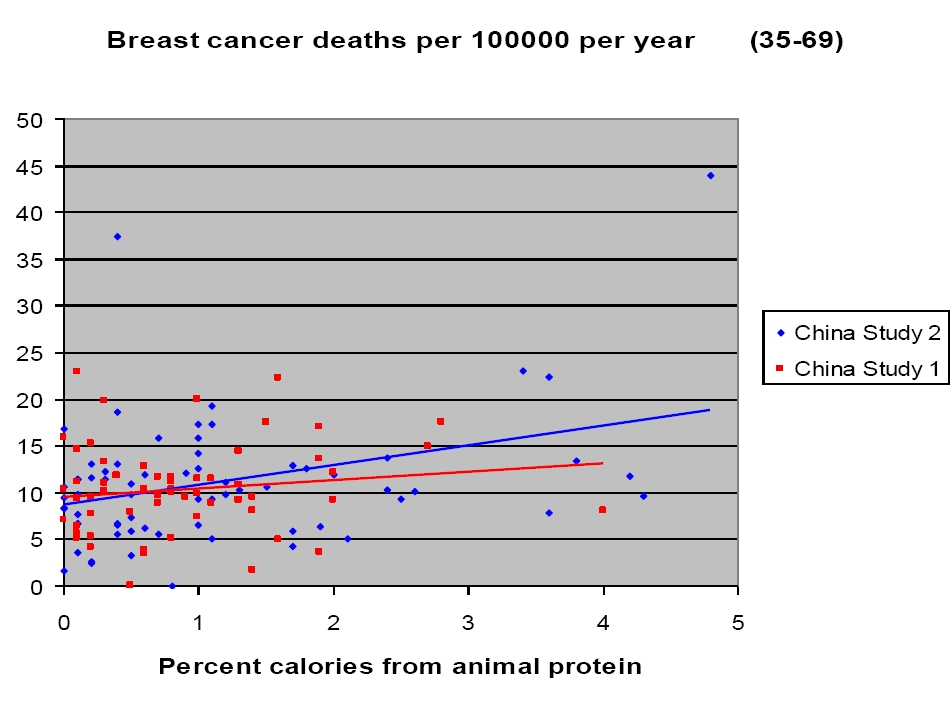 |
Comments from the China Study epidemiologist
"Trustworthy epidemiological evidence, it should be noted, always requires demonstration that a relationship holds for individuals (or perhaps small groups) within a large population as well as between large population groups."
"These examples [from the China study] suggest that although geographical correlations may give the right answer about causal relationships, they may also give misleadingly weak, misleadingly negative, or misleadingly positive answers..."
Richard Peto, the epidemiologist for both China Studies writing in the 1990 China Study monograph
 |
The China Study results clearly do not support the claim that reducing animal foods to zero reduces the risk of death either from all causes or from common Western diseases. But such studies are inherently weak evidence for any conclusion.
| 1999 pooled analysis | Regular meat-eaters | Occasional meat-eaters | Fish-eaters | Vegetarians | Vegans |
Heart disease | 1.00 | 0.8 | 0.66 | 0.66 | 0.74 |
All causes | 1.00 | 0.84 | 0.82 | 0.84 | 1.00 |
These results came from combining (pooling) the individual data from two studies from the USA, one from the UK and one from Germany. 66,274 people (including 753 vegans and 23,265 other vegetarians) were studied.
Recent comparisons of death rates in large numbers of individuals following different diets
| Meat-eater | Vegetarian | Vegan |
US Adventists (2003) including 668 vegans | 1.00 | 0.87 | 0.84 |
Germany (2005) Including 60 vegans | 1.00 | 1.08 | 1.59 |
These results were updates from further follow-up and analysis of US Adventists and a smaller German study (both groups were also part of the pooled analysis shown earlier).
B12 levels are much better in US Adventist vegans than in all other vegan groups studied, due to higher use of fortified foods and supplements.
How to judge health claims
Favour claims consistently supported by many different organisations and experts. This filters out most claims resting on inconclusive evidence or selective citation.
Pay little attention to claims based on comparisons between different countries or regions. Such comparisons cannot separate out the effect of the many different factors affecting
health.
Look for claims based on
- Observing the diet of many individuals in several different populations and monitoring subsequent health. [isolated reports can easily be due to confounding or chance]
- Direct comparisons of the effect of changing or not changing behaviour (randomised intervention trials - unfortunately not practicable for major long-term changes in diet).
Conclusions
- There is nothing unnatural or unhealthy about an entirely plant-based (vegan) diet.
- However, such diets are not a panacea for human ills.
- We should base our choices not on myths or wishful thinking but on solid evidence.